|
OVERVIEW
It was a week of strong late-summer migration for warblers in the air and herring in the river. As we read some of the entries, we can almost visualize a “river” of birds, butterflies, and fish heading south and toward the sea.
HIGHLIGHT OF THE WEEK
9/12 – Staatsburg, HRM 86: We have had an “out-of-stater” adult bald eagle hanging out along the river in Staatsburg. With my camera lens I was able to spot an orange band on its leg, a color used by both Massachusetts and Quebec.
- Terry Hardy
[For most of last winter, we had an immature bald eagle with an orange leg band hanging out in the tidal Wappinger Creek upstream from New Hamburg. It was first sighted on January 30 with subsequent sightings on February 17 and March and 17. That eagle had come from a nest at Mount Feake Cemetery, Waltham, Middlesex County, 13 miles west of Boston. - Tom Lake]
NATURAL HISTORY NOTES
9/9 – Albany County, HRM 143: I watched as a kettle of sixty broad-winged hawks circled over the Helderberg escarpment. It was shaping up to be a good migration day.
- Larry Alden (HMBirds)
[The Helderberg Escarpment is a geologic formation about 1,100 feet high, approximately ten miles west of Albany (see John Boyd Thatcher State Park). The escapement is a series of sedimentary rock layers from sandstone to limestone to chert. These are remnants of the deep past of the Hudson Valley beginning more than 400 million years ago when this part of the northeast was a shallow salt sea. - Tom Lake]
9/9 – Esopus Meadows, HRM 87: Scenic Hudson and Clearwater co-hosted a “Walk & Wade” at their Esopus Meadows Nature Preserve to dedicate the opening of their “Phenology Trail.” Scenic Hudson's Parks Manager Rita Shaheen’s opening remarks were interrupted by a bald eagle fly-by. Two dozen of us took a walk on the rail and found that spice bushes were sporting their red berries and tulip trees were dropping their first orange leaves. We pulled a seine on the high-water beach and caught three dozen banded killifish. The river was a nice warm 71 degrees Fahrenheit [F].
- Kate Phipps, Kristen Sullivan, Eli Schloss, Steve Naukam, Dave Lindemann
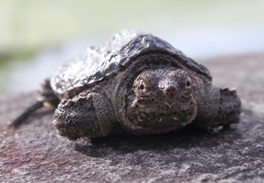 9/9 – Walden, HRM 65: Walking the loop trail around Olley Park after a heavy downpour, I came upon a quarter-size snapping turtle, probably just out of its nest. Since it had a long trek to reach the pond, I took it with me to release near the water's edge and watched as it headed underwater after once stopping to look around. Shortly afterwards, when I had reached the other side of the pond, I noticed a green heron land near the same area. Hopefully, the turtle had found a safe refuge in the mud. It's amazing to think that from such a tiny beginning can develop a hefty, bird-munching monster. [Photo of juvenile snapping turtle by Chris Bowser.] 9/9 – Walden, HRM 65: Walking the loop trail around Olley Park after a heavy downpour, I came upon a quarter-size snapping turtle, probably just out of its nest. Since it had a long trek to reach the pond, I took it with me to release near the water's edge and watched as it headed underwater after once stopping to look around. Shortly afterwards, when I had reached the other side of the pond, I noticed a green heron land near the same area. Hopefully, the turtle had found a safe refuge in the mud. It's amazing to think that from such a tiny beginning can develop a hefty, bird-munching monster. [Photo of juvenile snapping turtle by Chris Bowser.]
- Patricia Henighan
9/9 – Kowawese, HRM 59: We laid out our 40-foot seine in an early morning low tide. We quickly realized that our efforts would be shortened by the sheer volume of young-of-the-year [YOY] fishes that sparkled in the weak sunlight – the blueback herring were back. These small fish (43-68 millimeters) are fragile; just the cumulative weight of the catch on them can cause mortality. Coupled with being out of the warm water (71 degrees F) and up on the sand, could prove disastrous. We kept the net’s bag in a few inches of water while we collected enough to get a representative sample to identify and measure. There were far more resilient striped bass (47-72 mm) mixed in and a few yearling alewives (last year’s class; 92-97 mm). We eased the seine back into the water and the fish swam free, except for a few that ended up becoming a meal for blue crabs. The salinity was measured at 1.5 parts-per-thousand [ppt].
- Tom Lake, Phyllis Lake
9/9 – Verplanck, HRM 40.5: We had been watching a pair of osprey since they built their nest on the channel marker off Steamboat Dock in the early spring. We believe there was only one nestling since we never saw more than three birds on the nest at any time. It’s a wonder how this disheveled bunch of sticks held together in some of the nastiest weather. We have not seen any sign of the birds in several days so we assume all three have migrated downriver. The local cormorants who usually hang out on the marker will be happy to regain their prime fishing spot.
- Dianne Picciano, Phil Picciano
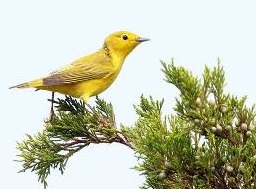 9/9 – Westchester County, HRM 30: We documented the presence of fourteen warbler species today in Rockefeller State Park Preserve. These included Tennessee, black-and-white, Nashville, American redstart, Cape May, northern parula, magnolia, bay-breasted, Blackburnian, chestnut-sided, blackpoll, black-throated blue, black-throated green, and Canada warblers.[Photo of Cape May warbler courtesy of Deb Tracy-Kral.] 9/9 – Westchester County, HRM 30: We documented the presence of fourteen warbler species today in Rockefeller State Park Preserve. These included Tennessee, black-and-white, Nashville, American redstart, Cape May, northern parula, magnolia, bay-breasted, Blackburnian, chestnut-sided, blackpoll, black-throated blue, black-throated green, and Canada warblers.[Photo of Cape May warbler courtesy of Deb Tracy-Kral.]
- Ann Swaim, Betsie Lategan, Debbie Van Zyl
9/9 – Yonkers, HRM 18: We had a public seining program today at our Sarah Lawrence College Center for the Urban River at Beczak. Atlantic silverside (33) were high count along with a mix of killifish (19 banded killifish, 20 mummichogs). Background catches included twenty shore shrimp and a single oyster toadfish.
- Elisa Caref
9/9 – Bedford, HRM 35: It was a big day for broad-winged hawks (197), counting for 90% of all migrant raptors at the Chestnut Ridge Hawkwatch. Non-raptor observations included monarchs (16), ruby-throated hummingbirds (17), and cedar waxwings waxwing (88). Four common nighthawks were spotted in the last hour.
-Silvan Laan, Charlotte Catalano, Allen Kurtz, Anne Swaim, Mike Paletta
9/10 – Bedford, HRM 35: It was another big day for broad-winged hawks (459), 92% of all migrant raptors at the Chestnut Ridge Hawkwatch. In the last hour we counted 205. The first two merlins of the season also moved past. Non-raptor observations included monarchs (3) and ruby-throated hummingbirds (5).
-Silvan Laan, Charlotte Catalano, Allen Kurtz
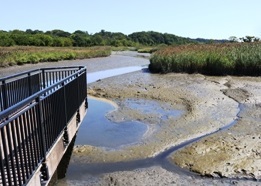 9/10 – Queens, New York City: The tidewater pond at the Alley Pond Environmental Center in Queens is fed by Little Neck Bay. More than 500 students from Macaulay Honors College came for this weekend’s 24-hour BioBlitz. Among the many different wildlife investigations, ours was confined to fish and aquatic life. The tidal pond was far too muddy to seine so we set out a dozen minnow traps baited with menhaden. We managed to lure four species of fish led by Atlantic silverside (56), mummichogs (54), and one YOY striped bass. We also caught Atlantic menhaden with a cast net tossing it out into schools that contained too many fish to count. Invertebrates included blue crabs, shore shrimp, sand shrimp, fiddler crabs, and comb jellies. Other shellfish present included oysters and barnacles. [Photo of low tide at Alley Pond Creek courtesy of Chris Bowser.] 9/10 – Queens, New York City: The tidewater pond at the Alley Pond Environmental Center in Queens is fed by Little Neck Bay. More than 500 students from Macaulay Honors College came for this weekend’s 24-hour BioBlitz. Among the many different wildlife investigations, ours was confined to fish and aquatic life. The tidal pond was far too muddy to seine so we set out a dozen minnow traps baited with menhaden. We managed to lure four species of fish led by Atlantic silverside (56), mummichogs (54), and one YOY striped bass. We also caught Atlantic menhaden with a cast net tossing it out into schools that contained too many fish to count. Invertebrates included blue crabs, shore shrimp, sand shrimp, fiddler crabs, and comb jellies. Other shellfish present included oysters and barnacles. [Photo of low tide at Alley Pond Creek courtesy of Chris Bowser.]
- Peter Park
[A “bio blitz” is a 24-hour biological inventory whose goal is to find as many organisms as possible. - Peter Park]
9/11 – Bedford, HRM 35: For the third straight day, broad-winged hawks (361) – 88% of all migrant raptors – dominated the count at the Chestnut Ridge Hawkwatch. We also had season high counts of sharp–shined hawks (23), and American kestrel (11). Non-raptor observations included monarchs (6) and ruby-throated hummingbirds (10). At the end of the day, a group of thirty common nighthawks came by.
-Silvan Laan, Charlotte Catalano, Steve Bauer
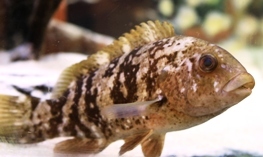 9/11 – Manhattan, HRM 1: We began our week by checking our research sampling gear in Hudson River Park at The River Project's sampling station on the lighthouse tender Lilac at 9/11 – Manhattan, HRM 1: We began our week by checking our research sampling gear in Hudson River Park at The River Project's sampling station on the lighthouse tender Lilac at
Pier 25. We were met with quite the haul in our crab pots: four adult tautog (220-275 mm), two male blue crabs (130 mm), a skilletfish (35 mm), and nearly a dozen juvenile spider crabs! [Photo of tautog courtesy of Chris Bowser.]
- Siddhartha Hayes
[We asked Siddhartha if the traps and pots are baited in an effort to entice aquatic life to enter. The answer: “We do not bait any of our traps for this study; our catch is just what passively wanders in.” - Tom Lake]
9/12 – Norrie Point, HRM 85: In late afternoon, after arriving at Norrie Point for a meeting, we were looking out toward Esopus Island when we saw a large dark bird rise from the water. It was an immature bald eagle with a fish it had just caught. It flew toward Norrie Point from the river channel northeast over the bay next to the environmental education center.
- Lane Smith, William Wise
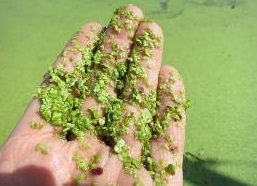 9/12 – Kowawese, HRM 61: In the low light of a foggy early morning, we were greeted by huge swaths of duckweed covering the shallows. Farther out, they were aligned to the ebbing current. The water had warmed a couple of degrees (73 degrees F) in the last three days and it felt wonderful. Salinity was measured at 2.0 ppt giving us hope for some brackish-water fishes. Given our huge haul of baby herring three days ago, we cautiously hauled our seine and were not surprised to see that the seaward pulse of young-of-the-year blueback herring (47-65 mm) was still passing by. The minority catch, by a large margin, was YOY striped bass. (70 mm). [Photo of duckweed courtesy of DEC Hudson River Estuary Program.] 9/12 – Kowawese, HRM 61: In the low light of a foggy early morning, we were greeted by huge swaths of duckweed covering the shallows. Farther out, they were aligned to the ebbing current. The water had warmed a couple of degrees (73 degrees F) in the last three days and it felt wonderful. Salinity was measured at 2.0 ppt giving us hope for some brackish-water fishes. Given our huge haul of baby herring three days ago, we cautiously hauled our seine and were not surprised to see that the seaward pulse of young-of-the-year blueback herring (47-65 mm) was still passing by. The minority catch, by a large margin, was YOY striped bass. (70 mm). [Photo of duckweed courtesy of DEC Hudson River Estuary Program.]
- Tom Lake, Phyllis Lake
[Common duckweed (Lemna minor) is a very small light green free-floating, flowering and seed-bearing, aquatic plant. Duckweed grows in water chestnut (Trapa natans) beds and then is released when the water chestnut breaks up in late summer. It cannot handle the currents in the main river but is released from fringing areas, such as tributaries and wetlands. - Stuart Findlay]
9/12 – Peekskill, HRM 43: It is called fishing, not catching, so in five hours of “angling” off the rip-rap, I caught only a single channel catfish (2.0 pounds). It was difficult to believe – just a couple of weeks ago I caught a dozen in the same spot. There was no sign of carp jumping or surfacing. I hope this was just a lull before the fall fishing season picks up. I'd heard that with a sharp change of weather, common carp will go off their feeding for a short period; maybe it's the same for the channel catfish.
- Bill Greene
9/12 – Bedford, HRM 35: Collectively, broad-winged hawks (194) and sharp–shined hawks (43) dominated the count at the Chestnut Ridge Hawkwatch. We also had a season-high count of American kestrel (23). In the afternoon a small falcon was thought to be a kestrel until a dark tail with white bands caught sunlight: merlin. Non-raptor observations included monarchs (33) and ruby-throated hummingbirds (14).
-Silvan Laan, Charlotte Catalano, J. Gardner, John Klem, Tait Johansson
9/12 – Manhattan, HRM 1: Under a warm end-of-summer sun we checked our collection gear in Hudson River Park at The River Project's sampling station on the lighthouse tender Lilac at Pier 25. In our crab pots we found two tautog (175, 270 mm) and two blue crabs (140 mm). In the killifish traps we found a tiny juvenile skilletfish (8.0 mm) and a juvenile butterfish (8.0 mm). Butterfish are not common at our sampling locations. We began catching them a few years ago but they do not show up every year.
- Siddhartha Hayes
[Butterfish (Peprilus triacanthus) are rather small (less than ten inches long) rhombus-shaped fishes (formerly in the genus Rhombus) recognizable by their lack of pelvic fins. While they are known to be prime forage for predators like bluefish and striped bass, the Gulf of Maine Institute describes them as “... one of our best table fish, fat, oily, and of delicious flavor.” - Tom Lake]
9/13 – Selkirk, HRM 135: My last hummingbird of the season was a loan female at the feeder. It was time to bring in the feeders for a thorough cleaning until next spring. Last year, I had my final hummingbird visit, also a female, on September 16.
- Roberta Jeracka
[Female ruby-throated hummingbirds are the last to arrive in the spring and the last to leave in the fall. - Tom Lake]
9/13 – Kingston, HRM 92: As I started driving onto the Kingston-Port Ewen Bridge early this morning, I spotted an adult bald eagle flying down Rondout Creek toward the Hudson River. It sailed across the bridge at about the mid-point, almost at the full height of the towers, before angling north onto the river. I had never seen an eagle at Rondout Creek and it made my day.
- Lauren Swartzmiller
[With migrating bald eagles now using the Hudson River Flyway, as well as the stay-at-home eagles, it is not easy to speculate on this eagle’s origin. One guess would be an adult from bald eagle nest NY92, about five miles southwest at Sturgeon Pool on the Wallkill River. - Tom Lake]
9/13 – Bedford, HRM 35: Compared to recent counts, it was a slow day at the Chestnut Ridge Hawkwatch. We did have a season high count for osprey (12) and bald eagles (6). Two merlins passed by, one flying through the rain as we were about to leave the watch. Non-raptor observations included monarchs (35) and ruby-throated hummingbirds (4). However, the best bird of the day was a red-headed woodpecker coming in from the east and passing low overhead.
- Silvan Laan, Charlotte Catalano, J. Gardner, John Klem, Tait Johansson
9/13 – Yonkers, HRM 18: This was our first of three groups of students that would be visiting our Sarah Lawrence College Center for the Urban River at Beczak this week from the Dalton School in Manhattan. The third-graders helped us seine the river and as the net came in, it looked as though it was filled with silver. In a way it was: Atlantic silversides. We also found YOY striped bass and one white perch. Among the invertebrates were blue crabs, mud crabs, comb jellies, moon jellyfish, and sand shrimp.
- Elisa Caref
9/13 – Manhattan, HRM 1: Checking our collection gear in Hudson River Park at The River Project's sampling station on the lighthouse tender Lilac at Pier 25, we found two blue crabs (120 mm) and two tautog (270, 330 mm). The larger “blackfish” was dazzling!
- Siddhartha Hayes, Nina Hitchings
9/14 – Saratoga County, HRM 182: There was very low light and threatening to rain this morning at Saratoga Spa State Park. We counted 33 bird species, including a good assortment of warblers, but missed others. Among the warblers were American redstart, Cape May, magnolia, bay-breasted, Blackburnian, blackpoll, palm, and black-throated green in various plumages.
- Ron Harrower (HMBirds)
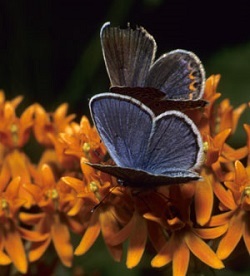 9/14 – Albany County, HRM 146: The Karner Barrens East trail at the Albany Pine Bush Preserve–remained a hot spot for migrant activity. Our Thursday birders walked the first half of the yellow trail today running across several mixed flocks. Warbler species included Tennessee, blackpoll, bay-breasted, Blackburnian, black-throated green, magnolia, Cape May, and northern parula, plus a handful of mysteries. 9/14 – Albany County, HRM 146: The Karner Barrens East trail at the Albany Pine Bush Preserve–remained a hot spot for migrant activity. Our Thursday birders walked the first half of the yellow trail today running across several mixed flocks. Warbler species included Tennessee, blackpoll, bay-breasted, Blackburnian, black-throated green, magnolia, Cape May, and northern parula, plus a handful of mysteries.
- Naomi Lloyd (HMBirds)
[The Albany Pine Bush, one of the largest of the 20 inland pine barrens in the world, was formed thousands of years ago following the Late Pleistocene drainage of Glacial Lake Albany. Pine Bush Preserve (a state nature preserve) covers 3,100 acres and holds a remarkable 45 “Species of Greatest Conservation Need,” including 16 birds, 17 insects, and 12 reptile and amphibian species. It also supports 20 at-risk plant and animal species listed as rare or endangered by the state or federal government. The Pine Bush is home to the Karner blue butterfly, an endangered species first identified by Vladimir Nabokov in 1944 using a type specimen from the Pine Bush. - Albany Pine Bush Preserve Commission] [Photo courtesy of NYSDEC.]
9/14 – Beacon, HRM 61: We watched a series of rain squalls move northeast over Storm King Mountain heading our way. Between the brief but heavy showers we hauled our seine looking for river herring but catching only YOY striped bass (64-71 mm), at least 50 per haul. When we had enough of that, we sat on tiderows of duckweed and watched monarch butterflies, at least seven, set off from the beach, quartering the slight southwest breeze, toward Orange County at least a mile away over open water. The river was 75 degrees F and the salinity had risen to 3.0 ppt, approaching 10% the strength of seawater.
- Tom Lake, B.J. Jackson
9/14 – Bedford, HRM 35: After several days with impressive numbers of broad-winged hawks at the Chestnut Ridge Hawkwatch, today we had none. High for the count was American kestrel (13). We spotted a merlin hunting what looked to be dragonflies over Westmoreland Sanctuary for the last half hour of the watch. Non-raptor observations included monarchs (18), ruby-throated hummingbirds (5), and common nighthawks (23)
- Charlotte Catalano, Tait Johansson
9/14 – Yonkers, HRM 18: This was our second of three groups of students that would be visiting our Sarah Lawrence College Center for the Urban River at Beczak this week from the Dalton School in Manhattan. The third-graders helped us seine the river and their catch was impressive. The featured fish was YOY striped bass (15), but also included banded killifish, American eel, white perch, and winter flounder. Perhaps even more impressive were the invertebrates: blue crabs (18), comb jellies, moon jellyfish, sand shrimp and grass shrimp, and soft shell clams. Most of the moon jellyfish we caught this week were the size of dimes with a few “pennies” mixed in. The majority of the blue crabs we caught were the size of a thumbnail, but some were the size of a child’s palm.
- Elisa Caref
9/15 – Minerva, HRM 284: I was out enjoying the warm zephyrs late this evening when, in the not-too-distant forest, I could hear three barred owls calling to each other. It seemed that they were being very polite: One would finish calling before another began. The pattern seemed like genuine communication, not just random calling.
- Mike Corey
9/15 – Bedford, HRM 35: We had some nice views of merlins today at the Chestnut Ridge Hawkwatch, with a total of five birds, a season high. In mid-afternoon we had four adult male American kestrels, a plumage that so far this season had been a minority compared to female-type birds. Broad-winged hawks (44) were back as high count. Non-raptor observations included good numbers of monarchs (47) as well as ruby-throated hummingbirds (9). Small groups of common nighthawk appeared in the late afternoon, possibly having breakfast before moving farther south.
- Silvan Laan, Steve Bauer
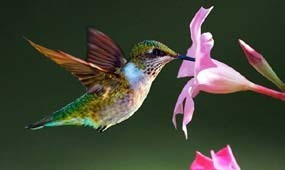 9/15 – Manhattan, HRM 2: St. Luke’s Garden in the West Village was inundated this month with monarch butterflies and ruby-throated hummingbirds mostly surrounding a large patch of milkweed and a very large butterfly bush. Since they are so territorial, I never saw more than two hummers at a time and one always chased the other away. There have also been many American redstarts this month. Farther east, in the East Village, a Cooper's hawk was tormenting our substantial colony of pigeons. [Photo of ruby-throated hummingbird courtesy of Tom McDowell.] 9/15 – Manhattan, HRM 2: St. Luke’s Garden in the West Village was inundated this month with monarch butterflies and ruby-throated hummingbirds mostly surrounding a large patch of milkweed and a very large butterfly bush. Since they are so territorial, I never saw more than two hummers at a time and one always chased the other away. There have also been many American redstarts this month. Farther east, in the East Village, a Cooper's hawk was tormenting our substantial colony of pigeons. [Photo of ruby-throated hummingbird courtesy of Tom McDowell.]
- Robert Shapiro
9/15 – Yonkers, HRM 18: This was our third of three groups of students that visited our Sarah Lawrence College Center for the Urban River at Beczak this week from the Dalton School in Manhattan. We hauled our 30-foot seine with high expectations and, while the fish were few (American eel, naked gobies, and winter flounder), the other aquatic life we captured more than made up for it. Our catch featured blue crabs (26), moon jellyfish (27), and shrimp (22; both shore and sand shrimp).
- Elisa Caref
[Young medusae (umbrella-shaped) moon jellyfish (Aurelia aurita) appear in the lower estuary in late summer and early fall. They are true jellyfish, plankton feeders, with several hundred fringed tentacles that serve as sticky collectors of both phytoplankton and zooplankton. Adult moon jellyfish, with a pinkish umbrella up to ten inches across, are most commonly associated with ocean beaches. They are frequently stranded at the high-tide line and, while non-stinging, have startled many a beach walker who happened to step on one. - Tom Lake]
9/15 – Manhattan, HRM 1: We checked our research sampling gear for the last time this week in Hudson River Park at The River Project's sampling station on the lighthouse tender Lilac at Pier 25. In our crab pots we found two adult blue crabs (120 mm) and two juveniles (less than 10 mm). There were fish as well, an impressive tautog (165 mm) and a larger oyster toadfish (210 mm).
- Siddhartha Hayes, Ashwin
FALL 2017 NATURAL HISTORY PROGRAMS
Sunday, September 23, 2:00 - 5:00 p.m.
Join us for our National Estuaries Day interactive “Science on the River” open house Hudson River Research Reserve’s Norrie Point Environmental Education Center. Help take a sediment core discover what it can teach us; canoe a tidal marsh or enjoy a live birds-of-prey program; help fish the waters around Norrie Point to find out who lives there; see how the types of organisms living in a stream indicate its health.
This program is free and most exhibit areas are wheelchair accessible.
Questions: 845-889-4745 x109
Thursday, October 12
The Hudson River Estuary Program’s 15th annual Day-in-the-Life” of the river.
For more information visit DEC's A Day in the Life webpage.
HUDSON RIVER MILES
The Hudson is measured north from Hudson River Mile 0 at the Battery at the southern tip of Manhattan. The George Washington Bridge is at HRM 12, the Tappan Zee 28, Bear Mountain 47, Beacon-Newburgh 62, Mid-Hudson 75, Kingston-Rhinecliff 95, Rip Van Winkle 114, and the Federal Dam at Troy, the head of tidewater, at 153. The tidal section of the Hudson constitutes a bit less than half the total distance – 315 miles – from Lake Tear of the Clouds to the Battery. Entries from points east and west in the watershed reference the corresponding river mile on the mainstem.
TO CONTRIBUTE YOUR OBSERVATIONS OR TO SUBSCRIBE
The Hudson River Almanac is compiled and edited by Tom Lake and emailed weekly by DEC's Hudson River Estuary Program. Share your observations by e-mailing them to trlake7@aol.com.
To subscribe to the Almanac (or to unsubscribe), use the links on DEC's Hudson River Almanac or DEC Delivers web pages.
Discover New York State Conservationist - the award-winning, advertisement-free magazine focusing on New York State's great outdoors and natural resources. Conservationist features stunning photography, informative articles and around-the-state coverage. Visit the Conservationist webpage for more information.
USEFUL LINKS
National Oceanic and Atmospheric Administration online tide and tidal current predictions are invaluable when planning Hudson River field trips.
For real-time information on Hudson River tides, weather and water conditions from twelve monitoring stations, visit the Hudson River Environmental Conditions Observing System website.
Information about the Hudson River Estuary Program is available on DEC's website.
Smartphone app available for New York outdoor enthusiasts!
DEC, in partnership with ParksByNature Network®, is proud to announce the launch of the New York Fishing, Hunting & Wildlife App for iPhone and Android. This FREE, cutting-edge mobile app gives both novice and seasoned outdoorsmen and women essential information in the palm of their hands. Powered by Pocket Ranger® technology, this official app for DEC will provide up-to-date information on fishing, hunting and wildlife watching and serve as an interactive outdoor app using today's leading mobile devices. Using the app's advanced GPS features, users will be able identify and locate New York's many hunting, fishing and wildlife watching sites. They will also gain immediate access to species profiles, rules and regulations, and important permits and licensing details.
NY Open for Hunting and Fishing Initiative
Governor Cuomo's NY Open for Fishing and Hunting Initiative is an effort to improve recreational opportunities for sportsmen and women and to boost tourism activities throughout the state. This initiative includes streamlining fishing and hunting licenses, reducing license fees, improving access for fishing and increasing hunting opportunities in New York State.
In support of this initiative, this year's budget includes $6 million in NY Works funding to support creating 50 new land and water access projects to connect hunters, anglers, bird watchers and others who enjoy the outdoors to more than 380,000 acres of existing state and easement lands that have gone largely untapped until now. These 50 new access projects include building new boat launches, installing new hunting blinds and building new trails and parking areas. In addition, the 2014-15 budget includes $4 million to repair the state's fish hatcheries; and renews and allows expanded use of crossbows for hunting in New York State.
This year's budget also reduces short-term fishing licenses fees; increases the number of authorized statewide free fishing days to eight from two; authorizes DEC to offer 10 days of promotional prices for hunting, fishing and trapping licenses; and authorizes free Adventure Plates for new lifetime license holders, discounted Adventure Plates for existing lifetime license holders and regular fee Adventure Plates for annual license holders.
Copies of past issues of the Hudson River Almanac, Volumes II-VIII, are available for purchase from the publisher, Purple Mountain Press, (800) 325-2665, or email purple@catskill.net.
|


 Hudson River Almanac
Hudson River Almanac 9/9 – Walden, HRM 65: Walking the loop trail around Olley Park after a heavy downpour, I came upon a quarter-size snapping turtle, probably just out of its nest. Since it had a long trek to reach the pond, I took it with me to release near the water's edge and watched as it headed underwater after once stopping to look around. Shortly afterwards, when I had reached the other side of the pond, I noticed a green heron land near the same area. Hopefully, the turtle had found a safe refuge in the mud. It's amazing to think that from such a tiny beginning can develop a hefty, bird-munching monster. [Photo of juvenile snapping turtle by Chris Bowser.]
9/9 – Walden, HRM 65: Walking the loop trail around Olley Park after a heavy downpour, I came upon a quarter-size snapping turtle, probably just out of its nest. Since it had a long trek to reach the pond, I took it with me to release near the water's edge and watched as it headed underwater after once stopping to look around. Shortly afterwards, when I had reached the other side of the pond, I noticed a green heron land near the same area. Hopefully, the turtle had found a safe refuge in the mud. It's amazing to think that from such a tiny beginning can develop a hefty, bird-munching monster. [Photo of juvenile snapping turtle by Chris Bowser.] 9/9 – Westchester County, HRM 30: We documented the presence of fourteen warbler species today in Rockefeller State Park Preserve. These included Tennessee, black-and-white, Nashville, American redstart, Cape May, northern parula, magnolia, bay-breasted, Blackburnian, chestnut-sided, blackpoll, black-throated blue, black-throated green, and Canada warblers.[Photo of Cape May warbler courtesy of Deb Tracy-Kral.]
9/9 – Westchester County, HRM 30: We documented the presence of fourteen warbler species today in Rockefeller State Park Preserve. These included Tennessee, black-and-white, Nashville, American redstart, Cape May, northern parula, magnolia, bay-breasted, Blackburnian, chestnut-sided, blackpoll, black-throated blue, black-throated green, and Canada warblers.[Photo of Cape May warbler courtesy of Deb Tracy-Kral.] 9/10 – Queens, New York City: The tidewater pond at the Alley Pond Environmental Center in Queens is fed by Little Neck Bay. More than 500 students from Macaulay Honors College came for this weekend’s 24-hour BioBlitz. Among the many different wildlife investigations, ours was confined to fish and aquatic life. The tidal pond was far too muddy to seine so we set out a dozen minnow traps baited with menhaden. We managed to lure four species of fish led by Atlantic silverside (56), mummichogs (54), and one YOY striped bass. We also caught Atlantic menhaden with a cast net tossing it out into schools that contained too many fish to count. Invertebrates included blue crabs, shore shrimp, sand shrimp, fiddler crabs, and comb jellies. Other shellfish present included oysters and barnacles. [Photo of low tide at Alley Pond Creek courtesy of Chris Bowser.]
9/10 – Queens, New York City: The tidewater pond at the Alley Pond Environmental Center in Queens is fed by Little Neck Bay. More than 500 students from Macaulay Honors College came for this weekend’s 24-hour BioBlitz. Among the many different wildlife investigations, ours was confined to fish and aquatic life. The tidal pond was far too muddy to seine so we set out a dozen minnow traps baited with menhaden. We managed to lure four species of fish led by Atlantic silverside (56), mummichogs (54), and one YOY striped bass. We also caught Atlantic menhaden with a cast net tossing it out into schools that contained too many fish to count. Invertebrates included blue crabs, shore shrimp, sand shrimp, fiddler crabs, and comb jellies. Other shellfish present included oysters and barnacles. [Photo of low tide at Alley Pond Creek courtesy of Chris Bowser.] 9/11 – Manhattan, HRM 1: We began our week by checking our research sampling gear in Hudson River Park at The River Project's sampling station on the lighthouse tender Lilac at
9/11 – Manhattan, HRM 1: We began our week by checking our research sampling gear in Hudson River Park at The River Project's sampling station on the lighthouse tender Lilac at  9/12 – Kowawese, HRM 61: In the low light of a foggy early morning, we were greeted by huge swaths of duckweed covering the shallows. Farther out, they were aligned to the ebbing current. The water had warmed a couple of degrees (73 degrees F) in the last three days and it felt wonderful. Salinity was measured at 2.0 ppt giving us hope for some brackish-water fishes. Given our huge haul of baby herring three days ago, we cautiously hauled our seine and were not surprised to see that the seaward pulse of young-of-the-year blueback herring (47-65 mm) was still passing by. The minority catch, by a large margin, was YOY striped bass. (70 mm). [Photo of duckweed courtesy of DEC Hudson River Estuary Program.]
9/12 – Kowawese, HRM 61: In the low light of a foggy early morning, we were greeted by huge swaths of duckweed covering the shallows. Farther out, they were aligned to the ebbing current. The water had warmed a couple of degrees (73 degrees F) in the last three days and it felt wonderful. Salinity was measured at 2.0 ppt giving us hope for some brackish-water fishes. Given our huge haul of baby herring three days ago, we cautiously hauled our seine and were not surprised to see that the seaward pulse of young-of-the-year blueback herring (47-65 mm) was still passing by. The minority catch, by a large margin, was YOY striped bass. (70 mm). [Photo of duckweed courtesy of DEC Hudson River Estuary Program.] 9/14 – Albany County, HRM 146: The Karner Barrens East trail at the Albany Pine Bush Preserve–remained a hot spot for migrant activity. Our Thursday birders walked the first half of the yellow trail today running across several mixed flocks. Warbler species included Tennessee, blackpoll, bay-breasted, Blackburnian, black-throated green, magnolia, Cape May, and northern parula, plus a handful of mysteries.
9/14 – Albany County, HRM 146: The Karner Barrens East trail at the Albany Pine Bush Preserve–remained a hot spot for migrant activity. Our Thursday birders walked the first half of the yellow trail today running across several mixed flocks. Warbler species included Tennessee, blackpoll, bay-breasted, Blackburnian, black-throated green, magnolia, Cape May, and northern parula, plus a handful of mysteries.  9/15 – Manhattan, HRM 2: St. Luke’s Garden in the West Village was inundated this month with monarch butterflies and ruby-throated hummingbirds mostly surrounding a large patch of milkweed and a very large butterfly bush. Since they are so territorial, I never saw more than two hummers at a time and one always chased the other away. There have also been many American redstarts this month. Farther east, in the East Village, a Cooper's hawk was tormenting our substantial colony of pigeons. [Photo of ruby-throated hummingbird courtesy of Tom McDowell.]
9/15 – Manhattan, HRM 2: St. Luke’s Garden in the West Village was inundated this month with monarch butterflies and ruby-throated hummingbirds mostly surrounding a large patch of milkweed and a very large butterfly bush. Since they are so territorial, I never saw more than two hummers at a time and one always chased the other away. There have also been many American redstarts this month. Farther east, in the East Village, a Cooper's hawk was tormenting our substantial colony of pigeons. [Photo of ruby-throated hummingbird courtesy of Tom McDowell.]